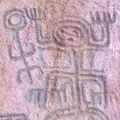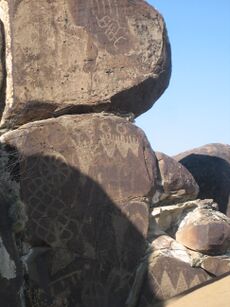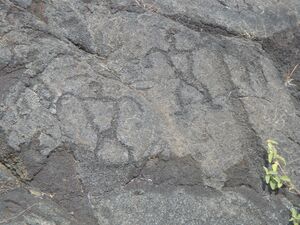پتروگليف
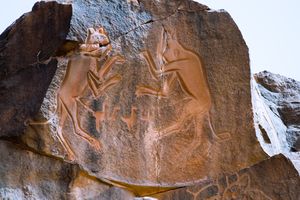


A petroglyph is an image created by removing part of a rock surface by incising, picking, carving, or abrading, as a form of rock art. Outside North America, scholars often use terms such as "carving", "engraving", or other descriptions of the technique to refer to such images. Petroglyphs, estimated to be 20,000 years old are classified as protected monuments and have been added to the tentative list of UNESCO's World Heritage Sites. Petroglyphs are found worldwide, and are often associated with prehistoric peoples. The word comes from the Greek prefix petro-, from πέτρα petra meaning "stone", and γλύφω glýphō meaning "carve", and was originally coined in French as pétroglyphe.
In scholarly texts, a petroglyph is a rock engraving, whereas a petrograph (or pictograph) is a rock painting.[1][2] In common usage, the words are sometimes used interchangeably.[3][4] Both types of image belong to the wider and more general category of rock art or parietal art. Petroforms, or patterns and shapes made by many large rocks and boulders over the ground, are also quite different. Inuksuit are not petroglyphs, but human-made rock forms found in Arctic regions.
History
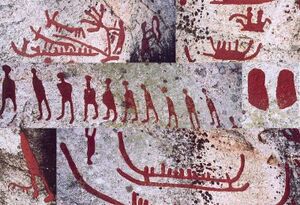
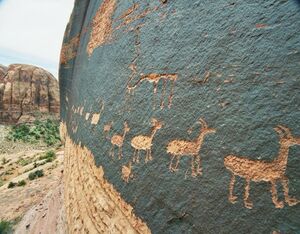
Petroglyphs have been found in all parts of the globe except Antarctica, with highest concentrations in parts of Africa, Scandinavia and Siberia, many examples of petroglyphs found globally are dated to approximately the Neolithic and late Upper Paleolithic boundary (roughly 10,000 to 12,000 years ago).
Around 7,000 to 9,000 years ago, following the introduction of a number of precursors of writing systems, the existence and creation of petroglyphs began to suffer and tail off, with different forms of art, such as pictographs and ideograms, taking their place. However, petroglyphs continued to be created and remained somewhat common, with various cultures continuing to use them for differing lengths of time, including cultures who continued to create them until contact with Western culture was made in the 19th and 20th centuries.[بحاجة لمصدر]
Interpretation
Many hypotheses exist as to the purpose of petroglyphs, depending on their location, age, and subject matter. Some petroglyph images most likely held a deep cultural and religious significance for the societies that created them. Many petroglyphs are thought to represent a type of symbolic or ritualistic language or communication style that remains not fully understood. Others, such as geocontourglyphs, more clearly depict or represent a landform or the surrounding terrain, such as rivers and other geographic features.[بحاجة لمصدر]
Some petroglyph maps, depicting trails, as well as containing symbols communicating the time and distances travelled along those trails, exist; other petroglyph maps act as astronomical markers. As well as holding geographic and astronomical importance, other petroglyphs may also have been a by-product of various rituals: sites in India, for example, have seen some petroglyphs identified as musical instruments or "rock gongs".[5]
Some petroglyphs likely formed types of symbolic communication, such as types of proto-writing.[6] Later glyphs from the Nordic Bronze Age in Scandinavia seem to refer to some form of territorial boundary between tribes, in addition to holding possible religious meanings. Petroglyph styles have been recognised as having local or regional "dialects" from similar or neighboring peoples. Siberian inscriptions loosely resemble an early form of runes, although no direct relationship has been established.
Petroglyphs from different continents show similarities. While people would be inspired by their direct surroundings, it is harder to explain the common styles. This could be mere coincidence, an indication that certain groups of people migrated widely from some initial common area, or indication of a common origin. In 1853, George Tate presented a paper to the Berwick Naturalists' Club, at which a John Collingwood Bruce agreed that the carvings had "... a common origin, and indicate a symbolic meaning, representing some popular thought."[7] In his cataloguing of Scottish rock art, Ronald Morris summarized 104 different theories on their interpretation.[8]
Other theories suggest that petroglyphs were carved by spiritual leaders, such as shamans, in an altered state of consciousness,[9] perhaps induced by the use of natural hallucinogens. Many of the geometric patterns (known as form constants) which recur in petroglyphs and cave paintings have been shown by David Lewis-Williams to be hardwired into the human brain. They frequently occur in visual disturbances and hallucinations brought on by drugs, migraine, and other stimuli.
The Rock Art Research Institute (RARI) of the University of the Witwatersrand studies present-day links between religion and rock art among the San people of the Kalahari Desert.[10] Though the San people's artworks are predominantly paintings, the beliefs behind them can perhaps be used as a basis for understanding other types of rock art, including petroglyphs. To quote from the RARI website:
Using knowledge of San beliefs, researchers have shown that the art played a fundamental part in the religious lives of its painters. The art captured things from the San's world behind the rock-face: the other world inhabited by spirit creatures, to which dancers could travel in animal form, and where people of ecstasy could draw power and bring it back for healing, rain-making and capturing the game.[11]
List of petroglyph sites
Africa
Algeria
Cameroon
Central African Republic
- Bambari, Lengo and Bangassou in the south; Bwale in the west
- Toulou
- Djebel Mela
- Koumbala
Chad
Republic of the Congo
- The Niari Valley, 250 km south west of Brazzaville
Egypt
- Qurta, on the east bank of the Nile River in the upper Nile valley, has Nubian Sandstone formations featuring the first and earliest known examples of petroglyphs in the region of North Africa, dating back to 19–15,000 years BP[12][13]
- Wadi Hammamat in Qift, many carvings and inscriptions dating from before the earliest Egyptian Dynasties to the modern era, including the only painted petroglyph known from the Eastern Desert and drawings of Egyptian reed boats dated to 4000 BCE
- Inscription Rock in South Sinai, is a large rock with carvings and writings ranging from Nabatean to Latin, Ancient Greek and Crusader eras located a few miles from the Ain Hudra Oasis. A second rock sites approximately 1 km from the main rock near the Nabatean tombs of Nawamis with carvings of animals including Camels, Gazelles and others. The original archaeologists who investigated these in the 1800s have also left their names carved on this rock.
- Giraffe petroglyphs found in the region of Gebel el-Silsila. The rock faces have been used for extensive quarrying of materials for temple building especially during the period specified as the New Kingdom. The Giraffe depictions are located near a stela of the king Amenhotep IV. The images are not dated, but they are probably dated from the Predynastic periods.
Ethiopia
Gabon
- Ogooue River Valley
- Epona
- Elarmekora
- Kongo Boumba
- Lindili
- Kaya Kaya
Libya
Morocco
- The Draa River valley.
- Taouz.[14]
- Akka
- Smara

Namibia
Niger
- Life-size giraffe carvings on Dabous Rock, Aïr Mountains
South Africa
- Driekops Eiland near Kimberley[15]
- ǀXam and ǂKhomani heartland in the Karoo, Northern Cape
- Wildebeest Kuil Rock Art Centre near Kimberley, Northern Cape
- Keiskie near Calvinia, Northern Cape
Tunisia[16]
- Ouesslat Mountain, Ain Kanfous[17] and Zamla[18]
- Tameghza[19]
- The Tataouine Region, in particular Ghomrassen[20] and Smar[21]
Zambia
- Nyambwezi Falls in the north-west province.
Asia
Rock carving on Cheung Chau Island, Hong Kong
Petroglyphs at Cholpon-Ata in Kyrgyzstan
Tamgaly petroglyphs in Kazakhstan
Buddhist carvings at Ili River in Kazakhstan
Petroglyphs on a rock wall found in the Sierra Madre mountain range, Rizal, Philippines
Armenia
- Ughtasar
- Paytasar
- Urtsadzor
- Aragats[22]
- Gegham mountains
- Vardenis ridge
- See also Armenian Eternity sign
Azerbaijan
China
- Helan Mountains in Yinchuan[23]
- Hua'an Engravings
- Kangjia shimenzi in Xinjiang[23]
- Lianyungan Rock Engravings
- Petroglyphs in Zhuhai
- Yin Mountains in Inner Mongolia[23]
- Chifeng Petroglyphs in Inner Mongolia
Georgia
Hong Kong
Eight sites in Hong Kong:
- Tung Lung Island
- Kau Sai Chau
- Po Toi Island
- Cheung Chau
- Shek Pik on Lantau Island
- Wong Chuk Hang and Big Wave Bay on Hong Kong Island
- Lung Ha Wan in Sai Kung
India
- Bhimbetka rock shelters, Raisen District, Madhya Pradesh, India.
- Kupgal petroglyphs on Dolerite Dyke, near Bellary, Karnataka, India.
- Kudopi, Sindhudurg District, Maharashtra, India.
- Konkan Petroglyphs, Ratnagiri, Maharashtra, India.
- Hiwale, Sindhudurg District, Maharashtra, India.
- Barsu, Ratnagiri District, Maharashtra, India.
- Devihasol, Ratnagiri District, Maharashtra, India
- Edakkal Caves, Wayanad District, Kerala, India.
- Kollur, Villupuram, Tamil Nadu 35 km from Villupuram in Tamil Nadu. A large dolmen with four petroglyphs that portray men with trident and a wheel with spokes has been found. The discovery was made by K.T. Gandhirajan. This is the second instance when a dolmen with petrographs has been found in Tamil Nadu, India.[24] In October 2018, petroglyphs were discovered in the Ratnagiri and Rajapur areas in the Konkan region of western Maharashtra. Those rock carvings which might date back to 10,000 BC, depict animals like hippopotamuses and rhinoceroses which are not found in that region of India.[25] Some carving depicts, what appears to be Pisces constellation.[26]
- Perumukkal, Tindivanam District, Tamil Nadu, India.
- Unakoti near Kailashahar in North Tripura District, Tripura, India.
- Usgalimal rock engravings, Kushavati river banks, in Goa[27]
- Ladakhi rock art in Ladakh, NW Indian Himalaya.[28]
- Ratnagiri Maharashtra Petroglyphs, An eight ftlong petroglyph in Devache Gothane village in Rajapur district, Maharashtra.[29].
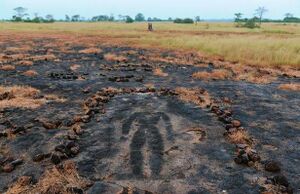 Goddess Lajja Gauri who is similarly portrayed, squatting and with legs facing outward
Goddess Lajja Gauri who is similarly portrayed, squatting and with legs facing outward
Kethaiyurumpu, Tamil Nadu. Situated 28 km north west of Dindigal, Tamil Nadu nearby Idaiyakottai and six km south west of Oddanchartam has revealed several petroglyphs mostly represent abstract symbols on two rocks, which looks like a temporary rock shelter were noticed adjacent to a Murugan temple which is in ruins on top of the Kothaiyurumbu hill.
Iran
During recent years a large number of rock carvings has been identified in different parts of Iran. The vast majority depict the ibex.[30][31] Rock drawings were found in December 2016 near Golpayegan, Iran, which may be the oldest drawings discovered, with one cluster possibly 40,000 years old. Accurate estimations were unavailable due to US sanctions.[32]
The oldest pictographs in Iran are seen in Yafteh cave in Lorestan that date back 40,000 and the oldest petroglyph discovered belongs to Timareh dating back to 40,800 years ago.
Iran provides demonstrations of script formation from pictogram, ideogram, linear (2300 BC) or proto Elamite, geometric old Elamite script, Pahlevi script, Arabic script (906 years ago), Kufi script, and Farsi script back to at least 250 years ago. More than 50000 petroglyphs have been discovered, extended over all Iran's states.[33][31][34]
Israel
- Kibbutz Ginosar
- Har Karkom
- Negev
Japan
- Awashima shrine (Kitakyūshū city)[35]
- Fugoppe Cave, Hokkaido[23]
- Hikoshima (Shimonoseki city)[35]
- Miyajima[35]
- Temiya cave (Otaru city)[36]
Jordan
Kazakhstan
- Koksu River, in Almaty Province
- Chumysh River basin,
- Tamgaly Tas on the Ili River
- Tamgaly – a World Heritage Site nearly of Almaty
Laos
South Korea
Kyrgyzstan
- Several sites in the Tien Shan mountains: Cholpon-Ata, the Talas valley, Saimaluu Tash, and on the rock outcrop called Suleiman's Throne in Osh in the Fergana valley
Macau
Malaysia
Mongolia
- Petroglyphic Complexes of the Mongolian Altai, UNESCO World Heritage site, 2011[37][38]
- Petroglyphs found in the area of Bayan-Ovoo.[39]
Pakistan
Philippines
Saudi Arabia
Petroglyphs at Mada'in Salih.
Petroglyphs of animals, Tabuk.
Islamic inscriptions, Qasim.
Thamudic inscriptions.
- "Graffiti Rocks", about 110 km SW of Riyadh off the Mecca highway
- Arwa, west of Riyadh
- al Jawf, near al Jawf
- al Jawf, Camel Carving Site
- Jubbah, Umm Samnan, north of Hail
- Janin Cave, south of Hail
- Yatib, south of Hail
- Milihiya, south of Hail
- Jebel al Lawz, north of Tabuk
- Wadi Damm, near Tabuk
- Wadi Abu Oud, near al Ula
- Shuwaymis, north of Madina
- Jebel al Manjour & Ratt, north of Madina
- Hanakiya, north of Madina
- Shimli
- Bir Hima, north of Najran
- Tathleeth, north of Najran
- Al-Magar, in Najd
Taiwan
- The Wanshan Rock Carvings Archeological Site near Maolin District, Kaohsiung, were discovered between 1978 and 2002.
Thailand
Vietnam
- Rock engravings in Sapa, Sa Pa, Lào Cai Province
- Rock engravings in Namdan, Xín Mần District, Hà Giang Province
Yemen
- Eriosh Petroglyphs, island of Socotra
Europe
Petroglyph in Roque Bentayga, Gran Canaria (Canary Islands).
Petroglyph at Dalgarven Mill, Ayrshire, Scotland.
Bronze Age petroglyphs depicting weapons, Castriño de Conxo, Santiago de Compostela, Galicia.
Labyrinth, Meis, Galicia.
Cup-and-ring mark, Louro, Muros, Galicia.
Deer and cup-and-ring motifs, Tourón, Ponte Caldelas, Galicia.
England
Finland
- Hauensuoli, Hanko, Finland
France
- Prehistoric rock engravings of the Fontainebleau Forest
- Vallée des Merveilles, Mercantour National Park, France
Ireland
Italy
- Rock Drawings in Valcamonica – World Heritage Site, Italy (biggest European site, over 350,000)
- Bagnolo stele, Valcamonica, Italy
- Grotta del Genovese, Sicily, Italy
- Grotta dell'Addaura, Sicily, Italy
- Rock Engravings in Grosio (in Valtellina), Italy
Northern Ireland
Norway
- Rock carvings at Alta, World Heritage Site (1985)
- Rock carvings in Central Norway
- Rock carvings at Møllerstufossen
- Rock carvings at Tennes
Portugal
Scotland
- Museum of Ayrshire Country Life and Costume, North Ayrshire
- Burghead Bull, Burghead
- Townhead, Galloway[40]
- Ballochmyle cup and ring marks
Spain
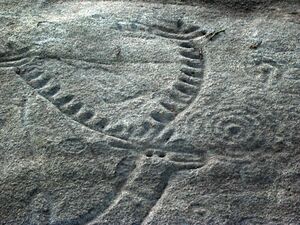
- Petroglyphs from Galicia
- Petroglyphs from the Canary Islands (Spain)
Russia
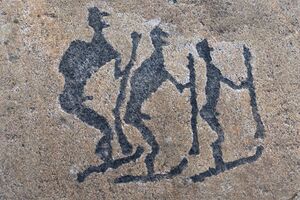
- White Sea petroglyphs, Republic of Karelia, Russia
- Petroglyph Park near Petrozavodsk–Lake Onega, Russia
- Tomskaya Pisanitsa
- Kanozero Petroglyphs
- Sikachi-Alyan, Khabarovsk Krai
- Kapova cave, Bashkortostan
- Sunduki Petroglyphs, Khakassia
Sweden
- Tanumshede (Bohuslän); World Heritage Site (1994)
- Himmelstalund (by Norrköping in Östergötland)
- Enköping (Uppland)
- Southwest Skåne (Götaland)
- Alvhem (Västra Götaland)
- Torhamn (Blekinge)
- Nämforsen (Ångermanland)
- Häljesta (Västmanland)
- Slagsta (Södermanland)
- Glösa (Jämtland)
- Gärde (Jämtland)
- Flatruet (Härjedalen)
- Grannberget (Härjedalen)
- The King's Grave at Kivik
- Fäbodristning from Dalarna
- Norrforsen (Umeå)[42]
- Släbro rock carvings in Nyköping (Södermanland)
Turkey
- Kagizman, Kars
- Cunni Cave, Erzurum
- Esatli, Ordu
- Gevaruk Valley, Hakkâri
- Hakkari Trisin, Hakkâri
- Latmos / Beşparmak
- Güdül, Ankara
Ukraine
Wales
Central and South America and the Caribbean
Argentina
- Cueva de las Manos, Santa Cruz
- Talampaya National Park, La Rioja
- Lihué Calel National Park, La Pampa
Petroglyph on Tunduqueral hill at Uspallata, Argentina
Aruba
Brazil
The oldest reliably dated rock art in the Americas is known as the "Horny Little Man." It is petroglyph depicting a stick figure with an oversized phallus and carved in Lapa do Santo, a cave in central-eastern Brazil and dates from 12,000 to 9,000 years ago.[43]
- Serra da Capivara National Park, a UNESCO World Heritage Site, Piauí
- Vale do Catimbau National Park, Pernambuco
- Ingá Stone, Paraíba
- Costao do Santinho, Santa Catarina
- Lagoa Santa (Holy Lake), Minas Gerais
- Ivolandia, Goiás
Chile
Colombia
El Abra archaeological site, Cundinamarca
Petroglyph in the Chiribiquete Natural National Park. (Possible equine)
Petroglyph in the Chiribiquete Natural National Park. Aboriginal.
Petroglyphs in the Chiribiquete Natural National Park.
Costa Rica
Dominican Republic
- Cueva de las Maravillas, San Pedro de Macorís
- Las Caritas, near Lake Enriquillo
- Los Tres Ojos, Santo Domingo
Grenada
Montserrat
Nicaragua
Paraguay
Peru
- Cumbe Mayo, Cajamarca
- Petroglyphs of Pusharo, Manú National Park, Madre de Dios region
- Petroglyphs of Quiaca, Puno Region
- Petroglyphs of Jinkiori, Cusco Region
Saint Kitts and Nevis
- Carib Petroglyphs, Wingfield Manor Estate, Saint Kitts
Suriname
Trinidad and Tobago
Venezuela
- Caicara del Orinoco, Bolívar
- Morrocoy National Park, Falcón
- Piedra Pintada Archeological Park within San Esteban National Park, Guaraca, Carabobo
- Sardinata Beach, Amazonas
- Taima Taima, Falcón
North America
Canada
- Kejimkujik National Park, Nova Scotia
- Petroglyph Provincial Park, Nanaimo, British Columbia[47]
- Petroglyphs Provincial Park, north of Peterborough, Ontario
- Agnes Lake, Quetico Provincial Park, Ontario
- Sproat Lake Provincial Park, near Port Alberni, British Columbia
- Stuart Lake, British Columbia
- St. Victor Provincial Park, Saskatchewan
- Writing-on-Stone Provincial Park, east of Milk River, Alberta
- Gabriola Island, British Columbia[48]
- East Sooke Regional Park, British Columbia
- Ancient Echoes Interpretive Centre, Herschel Saskatchewan
- Lake Temagami, Ontario[49]
Mexico
- Boca de Potrerillos, Mina, Nuevo León
- Chiquihuitillos, Mina, Nuevo León
- Cuenca del Río Victoria, near Xichú, Guanajuato
- Coahuiltecan Cueva Ahumada, Nuevo León
- La Proveedora, Caborca, Sonora
- Samalayuca, Juarez, Chihuahua
- Las Labradas, near Mazatlán, Sinaloa
United States


- Arches National Park, Utah
- Bandelier National Monument, New Mexico
- Barnesville Petroglyph, Ohio
- Bloomington Petroglyph Park, Utah
- Capitol Reef National Park, Utah
- Caguana Indian Park, Utuado, Puerto Rico
- Columbia Hills State Park, Washington[50]
- Corn Springs, Colorado Desert, California
- Coso Rock Art District, Coso Range, northern Mojave Desert, California[51]
- Death Valley National Park, California
- Dinosaur National Monument, Colorado and Utah
- Dighton Rock, Massachusetts
- Dominguez Canyon Wilderness, Colorado
- Fremont Indian State Park Utah
- Ginkgo Petrified Forest State Park Washington[52]
- Grand Traverse Bay Michigan
- Great Basin National Park Nevada
- Grimes Point, Nevada[53]
- Independence Slab, Ohio
- Inscription Rock (Kelleys Island, Ohio), Ohio
- Jeffers Petroglyphs, Minnesota
- Judaculla Rock, North Carolina
- Kanopolis State Park, Kansas
- La Cueva del Indio (Indians Cave), Arecibo, Puerto Rico
- La Piedra Escrita (The Written Rock), Jayuya, Puerto Rico
- Lava Beds National Monument, Tule Lake, California
- Legend Rock Petroglyph Site, Thermopolis, Wyoming
- Lemonweir Glyphs, Wisconsin
- Leo Petroglyph, Leo, Ohio[54]
- Mammoth Cave National Park, Kentucky
- Mesa Verde National Park, Colorado
- Newspaper Rock State Historic Monument, Utah
- Olympic National Park, Washington
- Paintlick Mountain, Tazewell, Virginia[55]
- Petit Jean State Park, Arkansas
- Petrified Forest National Park Arizona
- Petroglyph National Monument, New Mexico[56]
- Picacho Mountain, Picacho Arizona
- Picture Canyon, Flagstaff, Arizona
- Picture Rocks, Picture Rocks, Arizona
- Puye Cliff Dwellings, New Mexico
- Red Rock Canyon National Conservation Area, Nevada
- Rochester Rock Art Panel, Utah
- Ring Mountain, Marin County, California
- Saint John, U.S. Virgin Islands
- Sanilac Petroglyphs Historic State Park, Sanilac County, Michigan
- Sedona, Arizona
- Seminole Canyon, Texas
- Sloan Canyon National Conservation Area, Nevada
- South Mountain Park, Arizona
- The Cove Palisades State Park, Oregon
- Three Rivers Petroglyphs, New Mexico[57]
- Tibes Indian Park, Ponce, Puerto Rico
- Valley of Fire State Park, Nevada
- Washington State Park, Washington County, Missouri
- West Virginia glyphs
- White Mountain (Wyoming), Rock Springs, Wyoming
- White Tank Mountain Regional Park, Waddell, Arizona
- Winnemucca Lake, Nevada
- Writing Rock State Historical Site, North Dakota
- Monolyth at Caguas & El Yunque, Puerto Rico
- Track Rock, Union County Georgia
- Forsyth Petroglyph Originally discovered, locates and documented near Cumming, Georgia in Forsyth County but has been relocated to the campus of the University of Georgia in Athens, Georgia
Petroglyphs on a Bishop Tuff tableland, eastern California
Southern Utah
Southern Utah
Animal print carvings outside of Barnesville, Ohio
Upside-down man in Western Colorado
Rochester Rock Art Panel in the San Rafael Swell in Utah
Web-like petroglyph on the White Tank Mountain Regional Park Waterfall Trail, Arizona
Chipping petroglyph on the White Tank Mountain Regional Park Waterfall Trail, Arizona
Archer-like figure, Sanilac Petroglyphs Historic State Park, Sanilac County, Michigan
Oceania
Australia
- Arnhem Land / Kakadu National Park, Northern Australia
- Kings Canyon Resort / Watarrka National Park, Northern Australia
- Gosford Glyphs in Central Coast, NSW (widely regarded as archaeological forgery)
- Murujuga, Western Australia – world heritage assessed
- Sydney Rock Engravings, New South Wales
Ku-ring-gai Chase National Park, New South Wales
Ku-ring-gai Chase National Park, New South Wales
Ku-ring-gai Chase National Park, New South Wales
Mutawintji National Park, New South Wales
Burrup Peninsula, Western Australia
See also
- Geoglyph
- History of communication
- List of Stone Age art
- Megalithic art
- Pecked curvilinear nucleated
- Petrosomatoglyph
- Runestone and image stone
- Water glyphs
References
- ^ Wieschhoff, Heinrich Albert (1945). Africa. University of Pennsylvania Press.
Most noteworthy among the relics of Africa's early periods are the rock-paintings (petrographs) and rock-engravings (petroglyphs) which have been discovered in many parts of the continent.
- ^ T. Douglas Price (2012). Europe Before Rome: A Site-by-Site Tour of the Stone, Bronze, and Iron Ages. Oxford University Press. p. 116.
This art falls into two categories, depending on how it is made: petroglyphs are carved into rock, and pictographs are painted on the rock.
- ^ "petrograph". Merriam-Webster. Encyclopædia Britannica. Retrieved November 26, 2020.
- ^ Webster's Unabridged Dictionary of the English Language. Random House. 2001. p. 1449. ISBN 0-681-31723-X.
- ^ Ancient Indians made 'rock music'. BBC News (2004-03-19). Retrieved on 2013-02-12.
- ^ Houston, Stephen D. (2004-10-01). "The Archaeology of Communication Technologies". Annual Review of Anthropology. 33 (1): 223–250. doi:10.1146/annurev.anthro.33.070203.143724. ISSN 0084-6570.
- ^ J. Collingwood Bruce (1868; cited in Beckensall, S., Northumberland's Prehistoric Rock Carvings: A Mystery Explained. Pendulum Publications, Rothbury, Northumberland. 1983:19)
- ^ Morris, Ronald (1979) The Prehistoric Rock Art of Galloway and The Isle of Man, Blandford Press, ISBN 978-0-7137-0974-2.
- ^ [See: D. Lewis-Williams, A Cosmos in Stone: Interpreting Religion and Society through Rock Art (Walnut Creek, CA: Altamira Press, 2002).]
- ^ Rockart.wits.ac.za Archived 2017-07-30 at the Wayback Machine Retrieved on 2013-02-12.
- ^ "Rock Art Research Institute (RARI)". University of the Witwatersrand, Johannesburg. Retrieved 9 September 2017.
- ^ Huyge, Dirk; Vandenberghe, Dimitri A.G.; De Dapper, Morgan; Mees, Florias; Claes, Wouter; Darnell, John C. (21 November 2011). "First evidence of Pleistocene rock art in North Africa: securing the age of the Qurta petroglyphs (Egypt) through OSL dating". Antiquity. 85 (330): 1184–1193. doi:10.1017/S0003598X00061998. S2CID 130471822. Retrieved 30 May 2023.
- ^ "Egypt: The Aurochs of Qurta". World Archaeology (53). 28 May 2012. Retrieved 30 May 2023.
- ^ Gonzalo de Salazar,"The Chariots of Sahara", Adoranten, Tanum: Scandinavian Society for Prehistoric Art, 2000.
- ^ Parkington, J. Morris, D. & Rusch, N. 2008. Karoo rock engravings. Clanwilliam: Krakadouw Trust; Morris, D. & Beaumont, P. 2004. Archaeology in the Northern Cape: some key sites. Kimberley: McGregor Museum.
- ^ Ben Nasr, Jaafar (June 2015). "The Rock Art of Tunisia When, Why and to whom?". Expression (8).
- ^ Yahia-Acheche, Sophie (2013-06-02). "Ousselat (Jebel — ; Tunisie) : Préhistoire et art rupestre". Encyclopédie berbère (in الفرنسية) (36): 5986–5993. doi:10.4000/encyclopedieberbere.2870. ISSN 1015-7344.
- ^ Jaafar Ben Nasr (November 2021). "Les peintures rupestres de l'abri de Zamla (Jebel Ousselat – Tunisie centrale) : la représentation d'une planimétrie agraire ?". Antiquités Africaines. 57: 19–32.
- ^ Roux, Henri (1911). "Peinture Rupestre du Djebel-Bliji (Sud -Tunisien)". Bulletins et Mémoires de la Société d'Anthropologie de Paris. 2 (1): 31–32. doi:10.3406/bmsap.1911.8311.
- ^ Mohamed Elhedi Ghrabi (2009). "Les peintures rupestres de Ghomrassen" (PDF). Valcamonica Symposium. XXIII.
- ^ Ben Nasr, Jaâfar; Houla, Yassine (2020-10-01). "Les gravures rupestres d'Aïn Charchara (Smar-Tataouine; Sud-Est tunisien)". L'Anthropologie. Art préhistorique (in الفرنسية). 124 (3): 102762. doi:10.1016/j.anthro.2020.102762. ISSN 0003-5521. S2CID 225122514.
- ^ Khechoyan, Anna (January 2007). "The Rock Art of the Mt. Aragats System | Anna Khechoyan". Xxii International Valcamonica Symposium Rock Art in the Frame of the Cultural Heritage of Humankind l'Arte Rupestre Nel Quadro del Patrimonio Culturale dell'umanità,Centro Congressi - Darfo Boario Terme (Bs) Italy 18th - 24th May. Academia.edu. Retrieved 2013-08-18.
- ^ أ ب ت ث O'Sullivan, Rebecca (2018). "East Asia: Rock Art". Encyclopedia of Global Archaeology (2 ed.). Springer. pp. 1–11. doi:10.1007/978-3-319-51726-1_3131-1. ISBN 978-3-319-51726-1.
- ^ Dolmen with petroglyphs found near Villupuram. Beta.thehindu.com (2009-09-19). Retrieved on 2013-02-12.
- ^ "Prehistoric art hints at lost Indian civilisation". BBC. 1 October 2018.
- ^ "12000-year-old-petroglyphs-in-india". 8 November 2018.
- ^ Kamat, Nandkumar. "Prehistoric Goan Shamanism". The Navhind Times. Archived from the original on 7 August 2011. Retrieved 30 March 2011.
- ^ Petroglyphs of Ladakh: The Withering Monuments. tibetheritagefund.org
- ^ Sriram, Jayant (2018-10-20). "The petroglyphs of Ratnagiri". The Hindu (in الإنجليزية). ISSN 0971-751X. Retrieved 2021-06-23.
- ^ "Iran Petroglyphs – سنگ نگاره های ایران Iran Petroglyphs". iranrockart.com. Archived from the original on 2014-07-19.
- ^ أ ب "Middle East Rock Art Archive – Iran Rock Art Gallery". Bradshaw Foundation.
- ^ "Archaeologist uncovers 'the world's oldest drawings'". independent.co.uk. 12 December 2016.
- ^ "Iran Petroglyphs". iranrockart.com. Archived from the original on 2011-04-10.
{{cite web}}: CS1 maint: unfit URL (link) - ^ Universal Common language (book); Iran Petrogylphs, Ideogram Symbols (book); Rock Museums Rock Arts (Iran Petroglyphs) (book); For more information : https://www.independent.co.uk/news/world/middle-east/world-oldest-rock-drawings-archaeologist-iran-khomeyn-mohammed-naserifard-a7470321.html ; http://www.hurriyetdailynews.com/deciphering-irans-ancient-rock-art-.aspx?pageID=238&nID=107184&NewsCatID=375 ; http://theiranproject.com/blog/tag/dr-mohammed-naserifard/
- ^ أ ب ت Nobuhiro, Yoshida (1994) The Handbook For Petrograph Fieldwork, Chou Art Publishing, ISBN 4-88639-699-2, p. 57
- ^ Nobuhiro, Yoshida (1994) The Handbook For Petrograph Fieldwork, Chou Art Publishing, ISBN 4-88639-699-2, p. 54
- ^ Petroglyphic Complexes of the Mongolian Altai – UNESCO World Heritage Centre. Whc.unesco.org (2011-06-28). Retrieved on 2013-02-12.
- ^ Fitzhugh, William W. and Kortum, Richard (2012) Rock Art and Archaeology: Investigating Ritual Landscape in the Mongolian Altai. Field Report 2011. The Arctic Studies Center, National Museum of Natural History, Smithsonian Institution, Washington, D.C.
- ^ Prehistoric petroglyphs found in the area of Bayan-Ovoo (approximately 42,2379 N, 105,5360 E), as described and published by De Salazar Serantes in 1998 (“Discovery of Prehistoric Ruins in Gobi Desert”, by Gonzalo de Salazar Serantes, Adoranten1998. Tanum: Scandinavian Society for Prehistoric Art, 1998, pp 66-69).
- ^ "British Rock Art Blog | A Forum about Prehistoric Rock Art in the British Islands". Rockartuk.wordpress.com. Retrieved 2013-08-18.
- ^ Photos Archived 2011-03-01 at the Wayback Machine. Celticland.com. (2007-08-13). Retrieved on 2013-02-12.
- ^ "Umeå, Norrfors". Europreart.net. Retrieved 2013-08-18.
- ^ Choi, Charles. "Call this ancient rock carving 'little horny man'." Science on NBC News. 22 Feb 2012. Retrieved 9 April 2012.
- ^ "Settlers at La Silla". www.eso.org. Retrieved 6 June 2017.
- ^ "Llamas at La Silla". ESO Picture of the Week. Retrieved 29 April 2014.
- ^ أ ب "Ometepe Island Info – El Ceibo". ometepeislandinfo.com (in الإنجليزية). Retrieved 2017-03-05.
- ^ Petroglyph Provincial Park, Nanaimo, Vancouver Island BC Archived 2004-08-07 at the Wayback Machine. Britishcolumbia.com. Retrieved on 2013-02-12.
- ^ "Petroglyph Park - Gabriola Museum". gabriolamuseum.org. Retrieved 14 April 2018.
- ^ Bill Steer (27 Jul 2016). "Petroglyphs - Temagami's Rare Works of Art". Northern Ontario Travel. Retrieved 23 August 2020.
- ^ Keyser, James D. (July 1992). Indian Rock Art of the Columbia Plateau. University of Washington Press. ISBN 978-0-295-97160-5.
- ^ Moore, Donald W. Petroglyph Canyon Tours. Desertusa.com. Retrieved on 2013-02-12.
- ^ "Ginkgo Petrified Forest State Park".
- ^ Grimes Point National Recreation Trail, Nevada BLM Archaeological Site Archived 2006-12-06 at the Wayback Machine. Americantrails.org (2012-01-13). Retrieved on 2013-02-12.
- ^ Museums & Historic Sites Archived 2007-07-05 at the Wayback Machine. ohiohistory.org. Retrieved on 2013-02-12.
- ^ "Paint Lick". Craborchardmuseum.com. Archived from the original on 2007-12-26. Retrieved 2013-08-18.
- ^ "Petroglyph National Monument (U.S. National Park Service)". nps.gov.
- ^ Three Rivers Petroglyph Site Archived 2007-06-18 at the Wayback Machine. Nm.blm.gov (2012-09-13). Retrieved on 2013-02-12.
- Harmanşah, Ömür (ed) (2014), Of Rocks and Water: An Archaeology of Place, 2014, Oxbow Books, ISBN 1-78297-674-4, 9781782976745
- Rawson, Jessica (ed). The British Museum Book of Chinese Art, 2007 (2nd edn), British Museum Press, ISBN 978-0-7141-2446-9
- Sickman, Laurence, in: Sickman L. & Soper A., The Art and Architecture of China, Pelican History of Art, 3rd ed 1971, Penguin (now Yale History of Art), LOC 70-125675
للاستزادة
- Beckensall, Stan and Laurie, Tim, Prehistoric Rock Art of County Durham, Swaledale and Wensleydale, County Durham Books, 1998 ISBN 1-897585-45-4
- Beckensall, Stan, Prehistoric Rock Art in Northumberland, Tempus Publishing, 2001 ISBN 0-7524-1945-5
وصلات خارجية
- Rock Art Studies: A Bibliographic Database Bancroft Library's citations to rock art literature.
خطأ لوا في وحدة:Authority_control على السطر 278: attempt to call field '_showMessage' (a nil value).
- CS1 الفرنسية-language sources (fr)
- CS1 maint: unfit URL
- Short description is different from Wikidata
- Articles with hatnote templates targeting a nonexistent page
- Missing redirects
- Articles containing ألمانية-language text
- Articles containing إسپانية-language text
- Articles containing Ancient Greek (to 1453)-language text
- Articles containing فرنسية-language text
- Articles with unsourced statements from November 2020
- Articles with unsourced statements from May 2022
- Petroglyphs
- Rock art
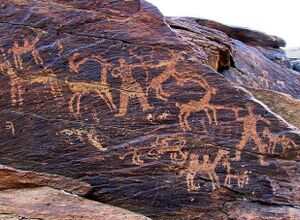
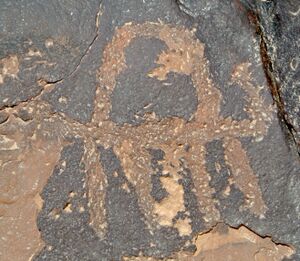
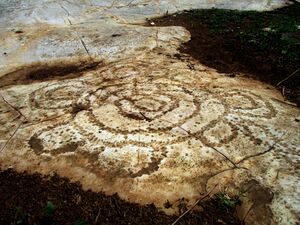






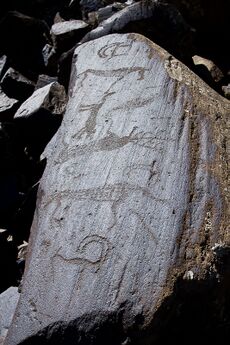
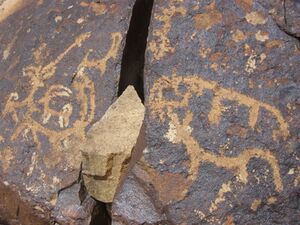
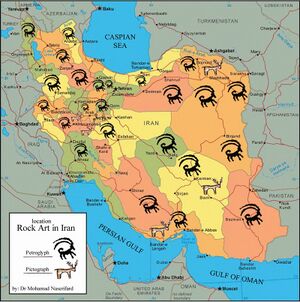
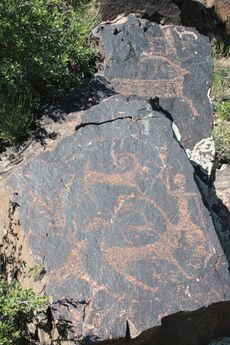



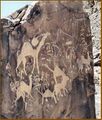
























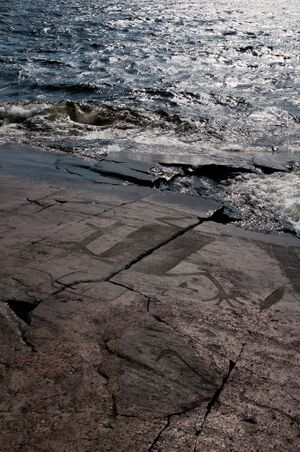
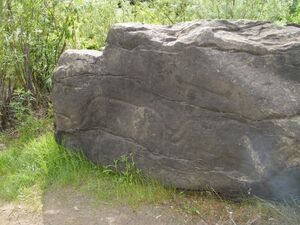





![Llamas at La Silla[45]](/w/images/thumb/a/ac/Llamas_at_La_Silla.jpg/80px-Llamas_at_La_Silla.jpg)

